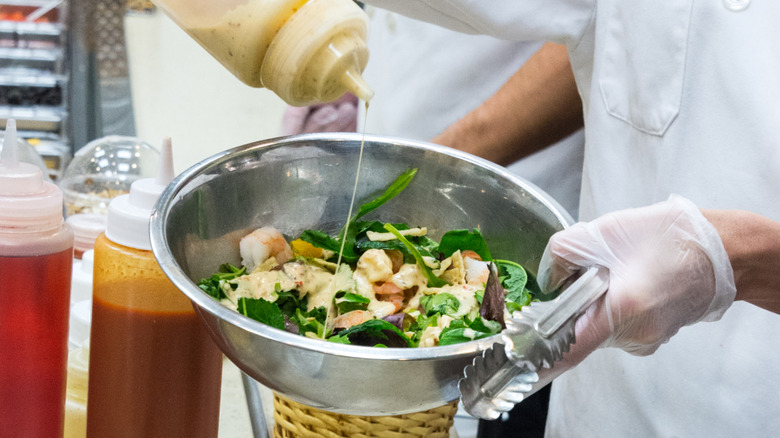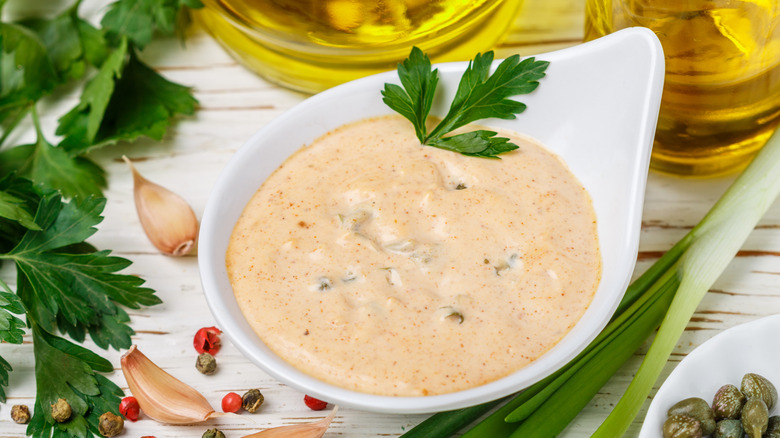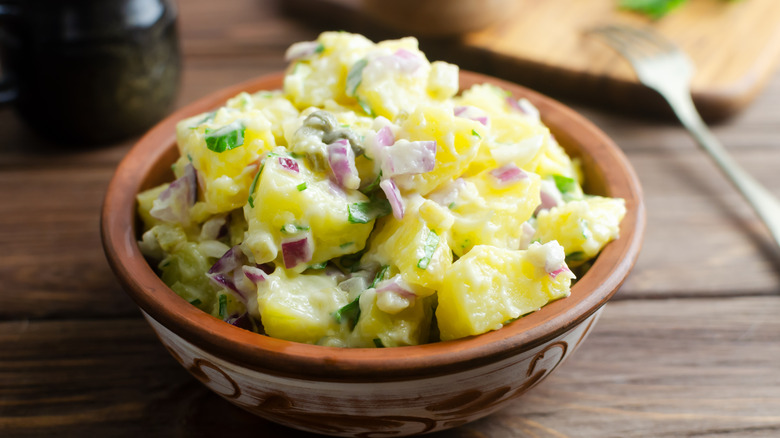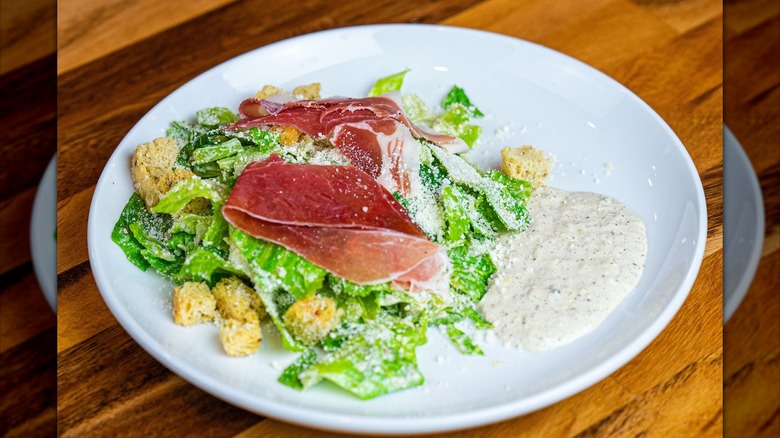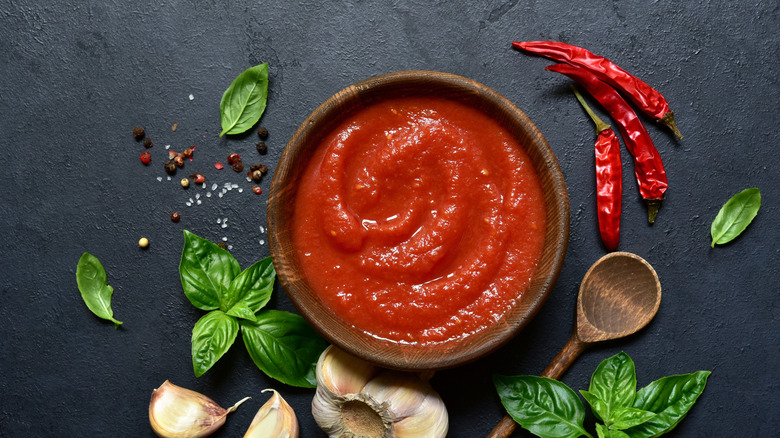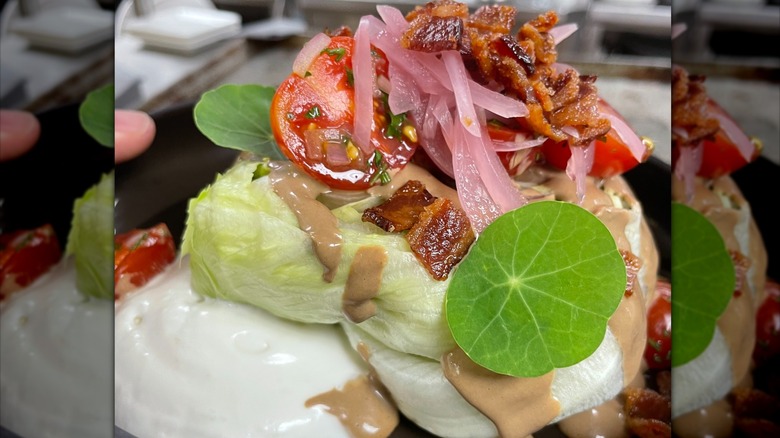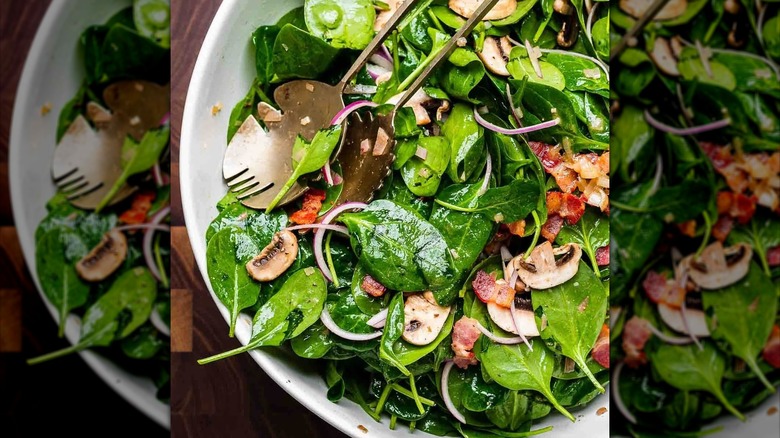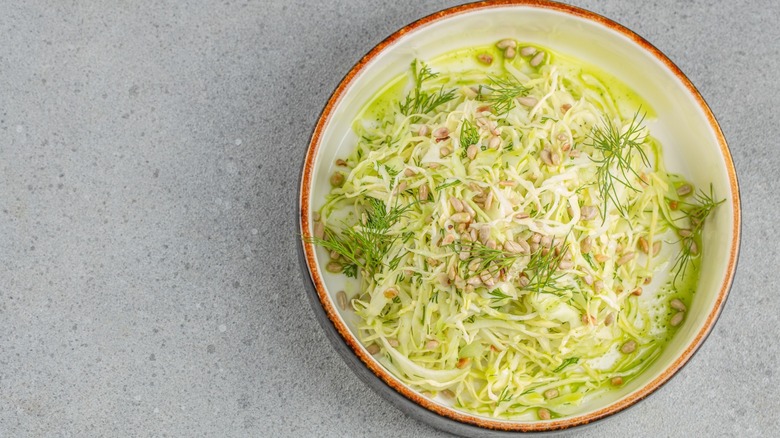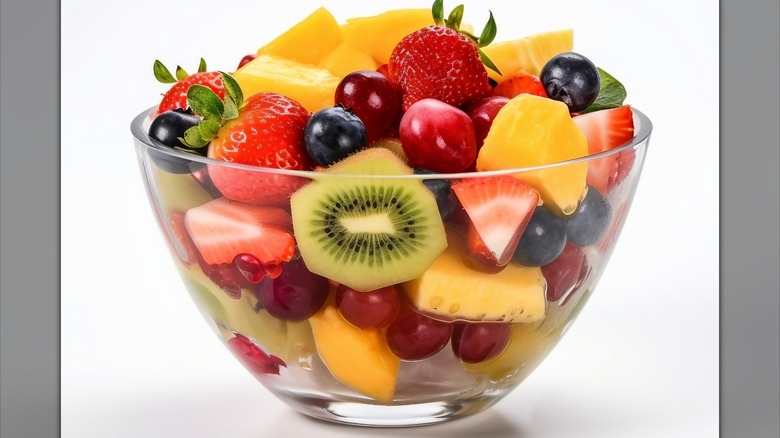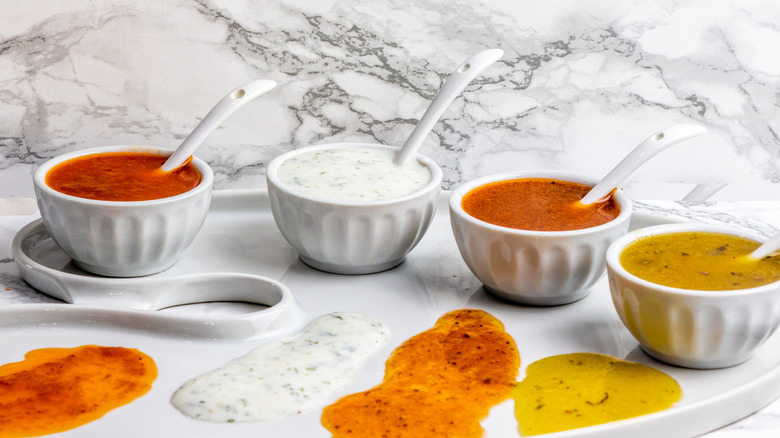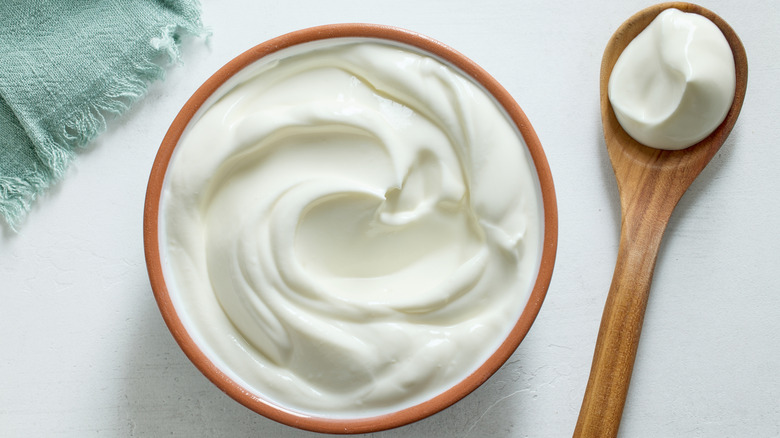10 Old-School Salad Dressings Everyone Used To Love But Slowly Forgot About
Whether you enjoy it as a starter, a side dish, or as a light main course, there's no argument that salad is certainly versatile. Many love a salad due to the customization available by selecting the ingredients to curb whatever flavor profile speaks to their cravings. But what can make or break a salad is your choice of dressing. People have long been dousing their vegetables with a tasty sauce to enhance the flavor and freshness. In fact, oil and vinegar served as a dressing for greens in the Babylonian era, 2,000 years ago. Over time, the popularity of salad dressings grew with home chefs perfecting their recipes. Prepared dressings also changed the salad dressing game in the early 1900s. Some are still available on grocery store shelves today from companies like Kraft, Wishbone, and Marzetti.
However, some once-beloved dressings did not quite stand the test of time. Sometimes the old-school salads themselves became less popular. The reasoning could be anything from a change in palates to the evolution and invention of new flavors. Read on to see if one of your old-time favorites is a forgotten dressing of the past. You may even find some inspiration to give your salads a refresh!
1. Southern Pacific dressing
The name of this dressing doesn't really give any hints to a specific flavor. But it does provide the dressing's background. Southern Pacific Railroad offered a Chef's Combination salad on its dining car menu in the early 1900s that featured a popular dressing only available to the passengers on board. Why the salad and its dressing were so popular is unclear, but it could be due to the railroad's boasting of its newly improved refrigeration skills, guaranteeing a crisp, fresh salad to be enjoyed on the road. Eventually, the Southern Pacific dressing made it out of the dining car to the dining rooms in the 1950s via cookbooks. The recipe starts off relatively normal with a mayonnaise, ketchup, mustard, and vinegar base. The uniqueness came from the dressing's sweetness, thanks to currant jelly.
Southern Pacific wasn't the only railroad with a sought-after dressing. Union Pacific Railroad also served a Chef's Salad Bowl with its own house-made garlic dressing or French dressing. Recipe cards from Union Pacific even shared the recipe for the house dressing (garlic, oil, seasonings, and a surprise kick from chili sauce.) It's unclear when exactly Southern Pacific dressing became less popular, but the railroad company's eventual closure in the 1990s and diners taking different travel methods could have had an impact.
2. Boiled dressing
Boiled dressing doesn't necessarily sound super enticing by name. But older generations may remember this sweet but savory, creamy dressing atop a variety of cold dishes, from fruit salad to pasta salads to traditional mixed greens or broccoli salad. The dressing filled the spot as an alternative option to a mayonnaise-based dressing before popular premade options like ranch came around. The texture was described as similar to hollandaise, but still containing an acidic element from mustard and vinegar. It took a bit of technique to make, as it contained eggs (separated), butter, milk, or half and half, heated in a double-boiler (but not fully boiled, as the name states). If the technique was off, your dressing texture would be a bit off, too.
It's unclear when exactly boiled dressing lost its popularity on prepared salads. Plentiful dressing options, other than mayonnaise or Miracle Whip, could have had boiled dressing get lost in the mix. It's certainly not offered as a dressing to a side salad at a restaurant or in the grocery store aisle, but you may have a homemade prepared salad with a dressing on it that you just can't match to a name that could be a variant of the boiled salad dressing.
3. Mayfair dressing
This dressing is one that was popular in a certain geographical area of the United States. The Mayfair dressing is said to have originated from the Mayfair Hotel's "house salad" in downtown St. Louis from the early 1900s, making it a St. Louis favorite. In fact, the Mayfair Salad was featured in the 1904 St. Louis World's Fair. The dressing itself was akin to a Caesar dressing, with anchovies being a key ingredient and homemade mayonnaise adding a creaminess. The Mayfair dressing was described as more of a garlic-forward flavor than a Caesar dressing, with a chunkier texture.
The hotel itself was open from 1924 until 2003, when it was closed and revamped into a Tribute Portfolio Hotel. Though you can't get the Mayfair dressing at the original establishment anymore, plenty of home cooks share recipes to recreate it at home on your own. You can even put the dressing atop the traditional salad of romaine lettuce, julienned ham, Swiss cheese, and croutons.
4. Tomato soup dressing
A soup base is a go-to for many home chefs looking to whip up delicious dishes. Canned soups are known to be great shortcuts in making sauces and casseroles. But what you may not realize is that the tomato soup can be a welcome accompaniment to more than just a grilled cheese sandwich. Tomato soup dressing was popular with older generations, appearing in cookbooks like "The Ford Treasury of Favorite Recipes from Famous Eating Places," circa 1950. The tomato soup dressing was well-known from the White Drum Inn in Orange, Massachusetts, which opened in 1934 and has since been demolished. Combined with tomato soup was an oil of your choice, vinegar, Worcestershire sauce, finely chopped onion, and green pepper. It was almost a salad in itself with the veggies added in, so it was a dressing for a salad as simple as just romaine lettuce.
Some people say that tomato soup dressing is comparable to French dressing. However, there are some slight differences with the addition of garlic and using the tomato soup as the base instead of tomato paste or puree. Next time you have an extra can of tomato soup lying around, try it in dressing and judge it yourself.
5. Williamsburg dressing
There may be a bit of debate over whether this dressing is directly inspired by the Colonial Williamsburg salad from the 1800s. Apparently, fresh summer salads were a key menu item in the 18th century, according to the 1824 "The Virginia Housewife," cookbook by Mary Randolph. But it certainly seems as if the version shared in the 1970s cookbook "Aglow in the Kitchen" is very similar. The recipe for the 1970s version of the dressing combined oil, vinegar, sugar, honey, dry mustard, paprika, celery seed and salt, and onion juice before boiling for three minutes. The Colonial Williamsburg version of the dressing is vinegar-forward, too, but also includes the yolks of hard-boiled eggs. It does omit some of the other seasonings, though, and doesn't require boiling.
Regardless of the exact dressing origins, this dressing was once a seasonal summer favorite that likely isn't top of mind for most (except maybe those dining while visiting Colonial Williamsburg).
6. Hot bacon dressing
Bacon fans, rejoice! There once was a pork-forward dressing that permeated dining tables. Hot bacon dressing is made from exactly what it sounds like — cooked bacon (and its drippings), combined with a sugar and vinegar mixture, cooked over low heat. Many diners reminisced about enjoying hot bacon dressing atop a spinach salad with fruit at family gatherings of the '70s or while dining at fancy restaurants. You likely will still see this dressing around the Pennsylvania Dutch and Amish communities, as they lay claim to inspiring and creating the dressing. However, there is some argument that the hot bacon dressing has ties back to Germany as the sauce used on traditional German potato salad (also served warm).
Nowadays, you won't see hot bacon dressing on a typical menu. But it is the star of the show in a "killed salad" or wilted salad, which is served warm. The evolved, upscale bacon vinaigrettes are likely inspired by the hot bacon dressing, topping dandelion salads and the spinach salads of today.
7. Celery seed dressing
Though many dressings may use celery seed as a seasoning ingredient, you likely won't find many as celery-forward as a 1950s celery seed dressing recipe. Celery seed dressing isn't an offering typically found in the condiment aisle — though you may find some variations that embody the same sweet and tangy combination. Traditional celery seed dressings were pretty simple, with sugar, mustard, vinegar, celery seed, onion, oil, and vinegar as the main ingredients. Not much else was needed to season the dressing, as the celery seed itself is tiny but packs a punch that amplifies an "earthy" flavor. The seeds also add a bit of texture to the dressing in their small form that doesn't go unnoticed even in a robust, crunchy salad.
Celery seed dressing topped many salads in a vinaigrette form, even though it appeared to be a bit creamy. You may more commonly find celery seed in a mayonnaise-based dressing like coleslaw nowadays, though it's not clear why the original dressing decreased in popularity.
8. Fruit salad dressing
Fruit salad is definitely still around, but the myriad of dressings that used to top the salads appear to have dwindled in popularity (though a dressing can certainly elevate a lackluster salad). Multiple recipes in the 1950s for Fruit Salad Dressing called for a variety of sweet and savory ingredients like a citrus-based fruit juice, vinegar, and celery seed. Some recipes even called for eggs to be beaten into the dressing and boiled until thickened, at which point whipped cream was added, once the dressing cooled.
While dressing a fruit salad is not a total necessity due to the fruit's natural sweetness, there are certain benefits to adding a dressing. You may find that the fruit salad at a luncheon has a certain quality that makes it irresistible — that could mean there is an added sugar boost from a dressing. Some people now just opt for adding lemon juice to fruit salad to prevent the fruit from browning. Whatever your reason may be for not dressing a fruit salad, taking an extra step and making a retro fruit salad dressing could be worth the effort.
9. Catalina dressing
Catalina dressing can be confused with French or Russian dressing due to the similar ingredients. Thousand Island dressing is another popular dressing in the reddish-orange category, but Catalina differs slightly from them all. The dressing is tangy and sweet with a bold red hue, thanks to ketchup as a main ingredient, but it has a little kick that other dressings don't have with cayenne. Though the exact origins of Catalina dressing are unknown, the dressing surged in popularity when Kraft brought it to market in the 1960s. Kraft still makes the dressing today, but you won't see any competitors on the store shelves – it trademarked it in 1962.
There are plenty of copycat Catalina dressing recipes available online if you are inclined to try a different "spicier" version akin to French dressing. Some swear by its flavor boost to pasta salads or as a dipping sauce. However, Catalina dressing is probably not on the list of dressings available on a side salad at restaurants.
10. Sour cream dressing
Another creamy but tangy dressing of the past had sour cream as the base instead of mayonnaise. It's unclear when sour cream dressing rose to popularity, but recipes for the dressing date back to as early as 1939. Some of the recipes even had home chefs add eggs and cook the dressing in a double-boiler to thicken it. Sour cream-based dressing is also popular in German cuisine as "Sauerrahm-Dressing," and used on traditional cucumber salads (though it is unclear if that dressing inspired the stateside version).
Sour cream dressing paired perfectly with potatoes, as well as in prepared salads like a slaw and as a dipping sauce. There are plenty of sour cream options to choose from at the store these days, but you probably would be hard-pressed to find a prepared "sour cream dressing." If you are really ambitious, you can even make your own sour cream at home. Otherwise, grab your favorite sour cream brand, some mustard, vinegar, and a pinch of paprika to recreate this retro dressing yourself.
